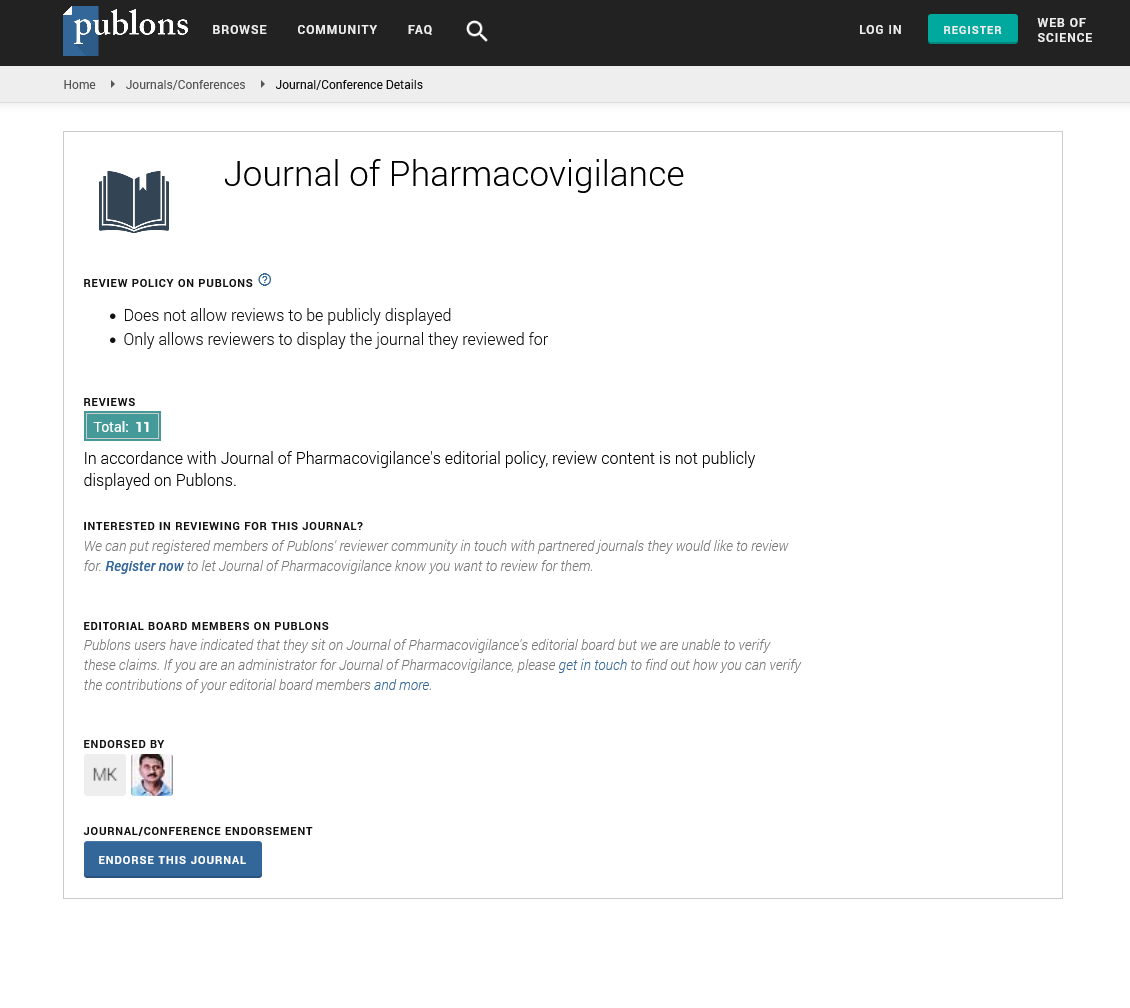Indexed In
- Open J Gate
- JournalTOCs
- The Global Impact Factor (GIF)
- RefSeek
- Hamdard University
- EBSCO A-Z
- OCLC- WorldCat
- Publons
- Euro Pub
- Google Scholar
Useful Links
Share This Page
Journal Flyer

Open Access Journals
- Agri and Aquaculture
- Biochemistry
- Bioinformatics & Systems Biology
- Business & Management
- Chemistry
- Clinical Sciences
- Engineering
- Food & Nutrition
- General Science
- Genetics & Molecular Biology
- Immunology & Microbiology
- Medical Sciences
- Neuroscience & Psychology
- Nursing & Health Care
- Pharmaceutical Sciences
Commentary Article - (2024) Volume 12, Issue 3
The Role of Pharmacovigilance in Vaccine Safety Assurance
Fariba Morgan*Received: 28-Aug-2024, Manuscript No. JP-24-27183; Editor assigned: 30-Aug-2024, Pre QC No. JP-24-27183(PQ); Reviewed: 13-Sep-2024, QC No. JP-24-27183; Revised: 20-Sep-2024, Manuscript No. JP-24-27183(R); Published: 27-Sep-2024, DOI: 10.35248/2329-6887.24.12.494
Description
Vaccine safety monitoring, also known as pharmacovigilance for vaccines, which involves in the continuous collection, analysis and evaluation of data on Adverse Events Following Immunization (AEFI). This proactive approach ensures that any potential risks associated with vaccines are promptly identified and addressed. Before a vaccine is approved for use, it undergoes extensive testing in clinical trials. These trials assess the vaccine's safety and efficacy in a controlled environment, involving thousands of participants. Data from these trials are rigorously analyzed to identify any adverse effects and ensure that the benefits of the vaccine outweigh the risks. Once a vaccine is approved and introduced into the general population, ongoing surveillance is essential to monitor its safety. Post-licensure surveillance includes passive reporting systems, active surveillance and observational studies. These systems collect data on AEFI from healthcare providers, patients and other sources, allowing for the detection of rare or long-term adverse events that may not have been evident in clinical trials. Effective communication of vaccine safety data is crucial for building public trust. Transparency in reporting adverse events, addressing misinformation and providing clear, evidence-based information about the benefits and risks of vaccination are essential components of risk communication. Public concerns about vaccine safety can stem from various sources, including misinformation, lack of understanding and historical incidents of vaccine-related issues. Transparency in vaccine safety monitoring processes and results is critical for building trust. Public health authorities and regulatory agencies should provide clear and accessible information about how vaccines are monitored, the types of data collected and the steps taken to address any identified risks. Openly sharing data on AEFI, including both common and rare events, helps to demystify the monitoring process and reassure the public that vaccine safety is a priority. Building trust in vaccines requires engaging with communities and understanding their specific concerns. Public health campaigns should be tailored to address the unique needs and beliefs of different populations. Community leaders, healthcare providers and trusted influencers can play a pivotal role in disseminating accurate information and addressing vaccine hesitancy. Misinformation about vaccines can spread rapidly, particularly on social media platforms. Public health authorities must proactively combat misinformation by providing timely, accurate and evidence-based information. Collaborating with social media companies to identify and address false claims can help to limit the spread of harmful misinformation.
Providing them with comprehensive training on vaccine safety, effective communication strategies and up-to-date information on AEFI can empower them to address patient concerns and promote vaccination. Passive reporting systems, such as the Vaccine Adverse Event Reporting System (VAERS) in the United States, allow healthcare providers and patients to report AEFI. These systems can provide more comprehensive and timely data on vaccine safety, allowing for the early detection of potential safety signals. Sentinel surveillance involves the monitoring of specific populations or healthcare settings to detect and investigate AEFI. This targeted approach can provide detailed data on vaccine safety in particular groups, such as pregnant women, children, or individuals with underlying health conditions.
Conclusion
Regulatory agencies, such as the U.S. Food and Drug Administration (FDA) and the European Medicines Agency (EMA), provided transparent and regular updates on the vaccine approval process, clinical trial data and post-licensure safety monitoring. Publicly accessible information, including detailed reports on AEFI, helped to reassure the public about the safety of COVID-19 vaccines. These systems included passive reporting, active surveillance and international collaboration. Data from these systems were analyzed and shared in real-time, enabling timely identification and communication of potential safety signals. Public health authorities engaged with communities through targeted campaigns, addressing specific concerns and promoting vaccination. Trusted community leaders, healthcare providers and influencers were enlisted to disseminate accurate information and encourage vaccination uptake. Efforts to combat misinformation were intensified, with public health authorities collaborating with social media platforms to identify and address false claims. Providing accurate and evidence-based information about COVID-19 vaccines helped to counteract misinformation and build public trust.
Citation: Morgan F (2024). The Role of Pharmacovigilance in Vaccine Safety Assurance. J Pharmacovigil. 12:494.
Copyright: © 2024 Morgan F. This is an open-access article distributed under the terms of the Creative Commons Attribution License, which permits unrestricted use, distribution, and reproduction in any medium, provided the original author and source are credited.

